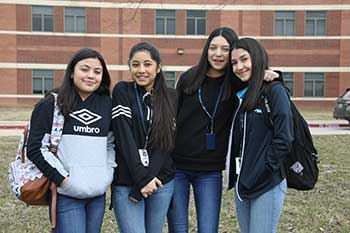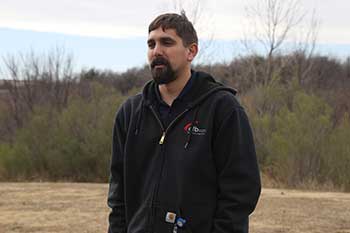 Discovery
Discovery

These Polk Middle School students noticed the injured hawk on the ground in December and alerted teachers.
On Dec. 11, students at Ted Polk Middle School noticed an injured red tailed hawk outside and alerted teachers, who in turn contacted the district’s maintenance department. One of the many duties carried out by CFB’s maintenance department is environment-friendly pest control. Red tailed hawks are a native species of raptor that plays a crucial role in naturally reducing rodent populations. When Randy Weinzetl, IPM Coordinator for CFB, arrived at Polk Middle School, he found the bird to be hurt, unable to fly, and barely able to walk. He then contacted Blackland Prairie Raptor Center for assistance helping the injured bird of prey.
Rescue
The hawk was named “Ted” by the maintenance crew, and safely transported to the raptor center for evaluation. Ted was injured from a window collision. The injury caused some short-term neurological damage and near-blindness in his left eye. Additionally, Ted suffered some minor wing damage. Ted was given medication and special protocols to help him heal.

Randy Weinzetl, Integrated Pest Management Coordinator for CFB, was called to help the injured bird. He contacted Blackland Prairie Raptor Center to rescue the animal in the hopes the bird could heal and return to the area after treatment.
Through various tests, including opportunities for him to fly and hunt live prey, Ted made a full recovery. From Ted’s weight, he was determined to be male (females typically weigh more than males in this species) and fairly young, due to still having juvenile tail feathers.
An adult red tailed hawk will typically consume the equivalent of 5 mice per day – over 25,000 mice in their life time. They will sometimes prey on smaller birds, rabbits and other small native game. They can live to 15 years of age. Details about Ted’s treatment, what he was fed, and the progress he made can be found online.
Release
After 43 days at the raptor center, Ted’s recovery was complete. He was transported back to Polk Middle School to be released. Since he was discovered at Polk, he was clearly familiar with the area, so it was the ideal location for him to be released. Some of the students that discovered him in December were present for his release.
Cold weather drives rodent populations toward human dwellings for warmth and they can cause infrastructure damage as they chew through whatever they can in order to enter a structure. Ted and other predators in the area serve as natural remedies for these pest problems. When Ted was released on Jan. 24, a kestrel was seen in a tree nearby. Kestrels are another bird of prey that also help to keep rodent populations down. Upon his release, Ted soared to a tree behind Polk and perched for several minutes, getting acclimated once again to his home territory.